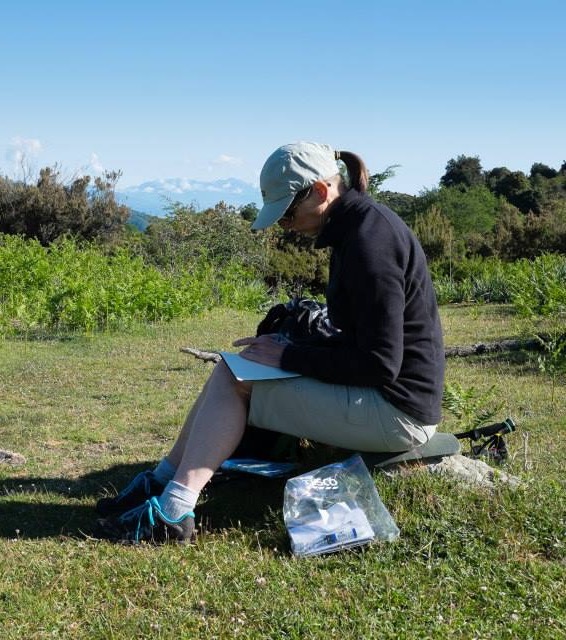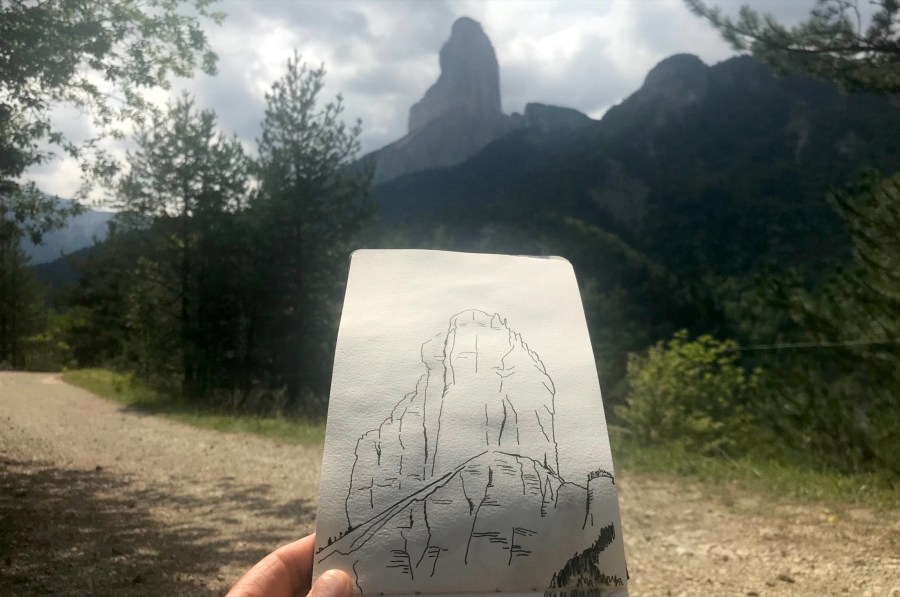Ever thought about sketching your walks? Liz Wakelin shares her tips, from getting started to drawing inspiration (pun intended) from other artists.
By Liz Wakelin
Sketching is one of the best ways to record a walk or trek. Photographs capture only an instant but a drawing takes so much longer, requiring an investment of time to draw the scene. It makes you look so closely at an environment that it is seared into the memory in a way that photos – for me at least – cannot do.
As I walk I find myself looking for something I know I’m capable of sketching that holds me ‘in the moment’, instead of my mind wandering away from the beauties of the trail. I have photos on my phone that I have no recollection of taking, but every sketch is clear and fresh in my mind.
So many people think they can’t draw, and it’s simply not true. Everyone can draw. A drawing is simply a picture or diagram made with pencil, pen or crayon. It’s not a photograph so it doesn’t need to look like one. I’m willing to bet that everyone drew as a child: it’s the first mark anyone makes on paper with a pencil. What most people mean by ‘I can’t draw’ is that they judge their drawings and find them wanting, but if your trail journal is for your eyes only then what does it matter what your drawings look like? They will improve with practice and they will always remind you of the place where you sat, the view that you saw, the rain that fell and splashed the page, the scent of mountain herbs.
“There’s something very pleasing about seeing words intertwined with the sketches. It is a joy to sit and stare: to gaze at a view and record it.”
When I set out for a long walk or multi-day backpack there is always a sense of stepping into the unknown. What will the weather do? Is the map accurate? Am I strong enough? And it’s the same with every sketch. I never know how a sketch will turn out so there is always a small adrenaline rush as the pen touches the white paper for the first time. Sometimes it doesn’t turn out how I had hoped but, just like getting lost when walking, there are ways of solving problems and turning a failing drawing into a success.
I’ve always scribbled and doodled but it wasn’t until I had a family that I started to keep sketchbooks. I was frustrated that we couldn’t walk as far with a small child but determined that she would always be part of our travels, so I bought a sketchbook to draw in when we stopped to rest. On our first backpacking trip along the Dales Way I kept a word and image journal of the journey. There’s something very pleasing about seeing words intertwined with the sketches. More recently it has become a handy tool to make me rest. It is a joy to sit and stare: to gaze at a view and record it. If time is short or weather conditions poor I’ll complete a sketch in my tent or a cafe, and often add watercolour later, using photos for reference.
There are no rules. I’ve learned to like my own style. And that is the key to enjoying your sketching: you have to let go of how you would like to draw and learn to enjoy the way you do draw. That will improve with practice and with looking at how others achieve their sketches.
And if you still feel uncertain then find a good teacher, or use an online drawing course. But definitely have a go. The artist Paul Klee described drawing as ‘taking a line for a walk’. So what’s stopping you?
Learning from other artists
There are so many excellent sketchbook artists to learn from. I would recommend starting with:
- Kolby Kirk’s Pacific Crest journals – thehikeguy.com/2011/11/10/pct-moleskines/
- Liz Steel – lizsteel.com
- Pete Scully – petescully.com
- Danny Gregory – dannygregory.com
- Also highly recommended: ‘An Illustrated Journey’, a collection of over forty sketchbook artists in their own words and images – dannygregorysblog.com/books/an-illustrated-journey/
Getting started
- Buy a sketchbook with quality paper (Moleskine sketchbooks or watercolour books are ideal).
- Buy a quality 2B pencil and a fine/medium black rollerball or gel pen (you can start with pencil but pen makes you commit to the drawing).
- Consider a small watercolour set or watercolour pencils (Winsor and Newton Cotman series / Derwent pencils are both good beginner sets).
- Draw what is easiest to draw: the skyline, a tent, a tree, a single aspect of the view.
- Simplify.
- You will discover what works for you!
Kit lists
My kit list for a day walk includes:
- Stillman and Birn Delta 8”x10” soft-cover sketchbook.
- Winsor and Newton 8-pan watercolour set.
- Water brush pen (brush with an internal water reservoir – which can be filled with gin or vodka for below-freezing conditions!)
- Three different fountain pens and maybe charcoal, pencil and eraser.
My kit list for a lightweight backpacking trip:
- Moleskine 5”x8” or 5.5”x3.5” watercolour sketchbook.
- Two gel pens, one extra fine and one fine – gel pens are less messy and the ink lasts longer than fountain pens on longer trips.
- Watercolour set plus waterbrush (optional)
 About the author
About the author
“I walk – a lot. I run – a little. And I hike – occasionally. I’m lucky enough to live in two beautiful places: Hampshire and Cumbria, although if truth be told, the mountains win hands down.
“Over the years I’ve backpacked numerous long-distance trails, often in the company of my daughter or husband. The most memorable of these was when my daughter and I walked from Winchester to Windermere.”
Read her blog at lizziwake.wordpress.com
Follow her on Twitter at @liziwake













